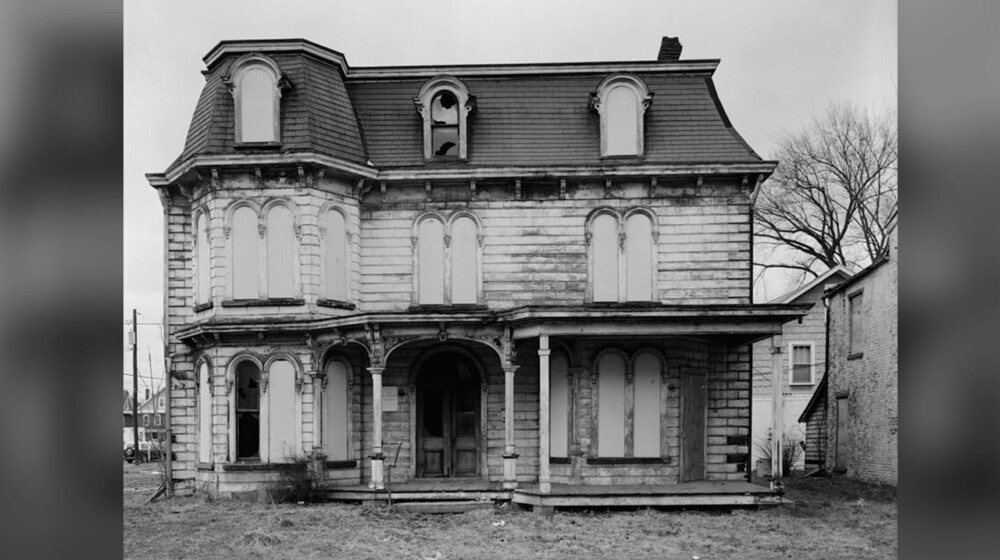Haunted Houses
Posted October 1, 2024
Written by Heather Roberts, Research Historian
For a printable version of this article, please click here.
Did you know…
“There was an air of desertion and desolation about the premises
that I confess sent a chill through me at the very first.”
– The Arizona Sentinel, April 27, 1889
Tales of ghosts and haunted houses date back into antiquity. The ancient Mesopotamian Epic of Gilgamesh (2,100 BCE) includes the ghost of his friend, Enkidu, who tells Gilgamesh about the Underworld. In Homer’s ancient Greek epic, The Odyssey (8-7 BCE), Odysseus travels to the Underworld to speak to several ghosts for advice, including the ghost of his mom. And a letter from ancient Roman senator, Pliny the Younger, tells of a philosopher who rented a house in Athens around the 1st century CE, only to find it inhabited by a ghost. Finding a long-dead body buried on the grounds, he arranges for its proper burial, and the spirit is finally able to rest.
-
Poem: Haunted Houses - by Henry Wadsworth Longfellow (1858)
All houses wherein men have lived and died
Are haunted houses. Through the open doors
The harmless phantoms on their errands glide,
With feet that make no sound upon the floors.We meet them at the door-way, on the stair,
Along the passages they come and go,
Impalpable impressions on the air,
A sense of something moving to and fro.There are more guests at table than the hosts
Invited; the illuminated hall
Is thronged with quiet, inoffensive ghosts,
As silent as the pictures on the wall.The stranger at my fireside cannot see
The forms I see, nor hear the sounds I hear;
He but perceives what is; while unto me
All that has been is visible and clear.We have no title-deeds to house or lands;
Owners and occupants of earlier dates
From graves forgotten stretch their dusty hands,
And hold in mortmain still their old estates.The spirit-world around this world of sense
Floats like an atmosphere, and everywhere
Wafts through these earthly mists and vapours dense
A vital breath of more ethereal air.Our little lives are kept in equipoise
By opposite attractions and desires;
The struggle of the instinct that enjoys,
And the more noble instinct that aspires.These perturbations, this perpetual jar
Of earthly wants and aspirations high,
Come from the influence of an unseen star
An undiscovered planet in our sky.And as the moon from some dark gate of cloud
Throws o’er the sea a floating bridge of light,
Across whose trembling planks our fancies crowd
Into the realm of mystery and night,—So from the world of spirits there descends
A bridge of light, connecting it with this,
O’er whose unsteady floor, that sways and bends,
Wander our thoughts above the dark abyss.
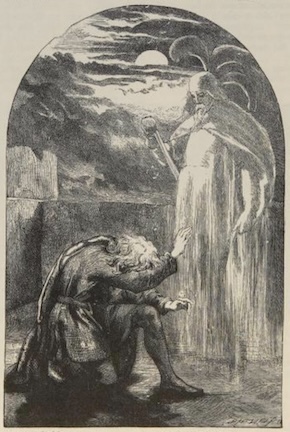
Hamlet, with the ghost of his father, from The Illustrated Shakespeare Library.
EERIE ENTERTAINMENT
Many of the earliest stories of spectral encounters were purpose-driven, reminding their audience to treat the dead with honor, using traditional burials and burial rites, and to answer questions about death in general. And though subsequent tales about ghosts frequently focused on lessons of morality, they eventually found their way into stories meant specifically to entertain, and people seemed to love them. Ghosts are influential characters in several of Shakespeare’s plays, including Julius Caesar (1599), Hamlet (1601), and MacBeth (1607). Just over a hundred years later, people were enjoying the comedic play, The Drummer: or, the Haunted House, written by Joseph Addison (1716 – though we found ads for the play in British and the American colonial newspapers from 1728-1791). The Haunted Tower, a play written by James Cobb and Stephen Storace premiered on stage in London in 1789 and continued to have some success in America into the 19th century.
Ghosts and ghouls in literature could be everything from seriously spooky to comically creepy. Gothic literature, with its mysterious towers, gloomy moors, and dark atmospheres were the perfect place for tales of otherworldly visitors and unnatural happenings. Edgar Allan Poe’s The Fall of the House of Usher (1839) and Henry James’s Turn of the Screw (1898) are both excellent examples of using the ominous atmosphere of a house to create an unsettling atmosphere for a story. Though like the latter two plays mentioned in the paragraph above, not all ghostly tales were so sinister. In A Christmas Carol (1843), written by Charles Dickens, some spirits were friendly or helpful instead of spooky, and the story has a happy outcome for Scrooge and Tiny Tim in the end. The Canterville Ghost (1887), written by Oscar Wilde, tells the tale of an American family who move into a haunted castle in England, and then proceed to “haunt” the ghost!
Books and plays didn’t have a monopoly on ghostly tales, though – they were also common in newspapers. Some stories were used as entertainment, whether to scare or moralize, and some as actual news reports. Benjamin Franklin’s newspaper, The Pennsylvania Gazette, (April 16, 1730) told the tale of a noisy spirit that haunted the room of a reverend who was traveling south of Philadelphia on church business. In 1813, a handful of newspapers reported on a court case in New York that had on one side a landlord demanding $42 in rent, and on the other, the man who had rented the home and said he couldn’t live there because the house was haunted. The jury found that the plaintiff was owed just $10 for the time the renter actually stayed in the home, but nothing after the ghostly happenings drove the renter and his family away.
Most tales of hauntings in newspapers – whether shared as fact or fiction – reveal not actual ghosts or ghouls, but flesh and blood people who were usually trying to coverup either improper behavior or criminal activity. The Vermont Gazette (July 15, 1792) shared a story of a young servant woman who got in trouble when she was discovered to be pregnant. She said she had been so scared of a supposed ghost, she let a fellow servant talk her into going to bed with him, and “liked his company better than the ghost’s”. In a story of a haunted house told “by a sceptic” in The Arizona Sentinel (April 27, 1889), a man reported staying in an old, abandoned mansion outside of New Orleans for a bet. Instead of ghosts, he came across a group of thieves who had been using the place, along with its “haunted” reputation, as their headquarters. He shot and wounded one of the thieves who had dressed up as a ghost, and was able to get the stolen items back to their owners. Not to be left out, Arizona criminals got into the “spirit of things” with a haunted house, too – the Arizona Silver Belt (June 29, 1905) reported that a ring of counterfeiters had been using a supposed haunted house on the outskirts of Phoenix as their base of operations, though they escaped before the house was inspected by the police.
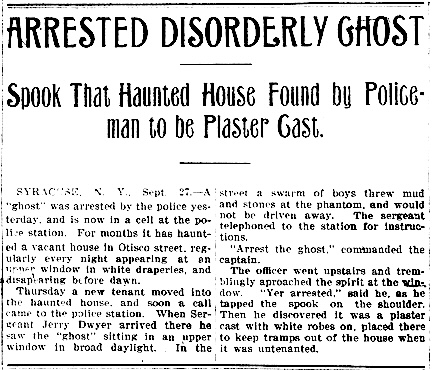
Article from The Tucson Citizen newspaper, September 27, 1902.
Sometimes houses rumored to have ghosts were imagined to be haunted just because of their notoriety. A man’s murder in a house southeast of Salem, Oregon was enough to start hearsay that it was haunted, with The Oregonian (August 26, 1870) reporting the house was “rotting away on the strength of its reputation”. Another story from the Arizona Silver Belt (June 16, 1894), told of a house in London that people refused to make deliveries to, insisting that it was haunted because of a murder that had taken place there years before. A handful of “hauntings”, however, were found to have been caused by animals instead of people or apparitions, including houses “haunted” by a goose, a poodle, and a wild pig!
Still, ghost stories remained popular, and although tales were told of haunted castles, towers, inns, mines, beaches, glades, and even a railroad car (it evidently behaved in an “unnatural fashion” – though don’t ask us what that entails!), the favorite “haunted spots” were houses.
UNCANNY ARCHITECTURE
“There is…a stillness which has its counterpart in the calm preceding a storm, an ominous lull, (eerie), void, inhuman. These dead American houses – Victorian in architecture generally, ugly, whimsical exaggerations in tortured wood – are haunted.”
– Guy Pène du Bois, American painter and art critic
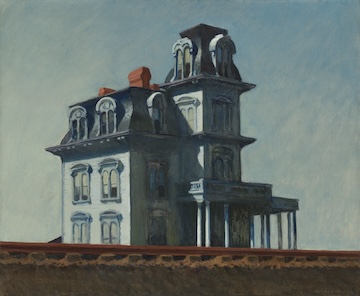
House by the Railroad by Edward Hopper, 1925, Modern Museum of Art.
Despite stories of ghostly experiences predating the age by millennia, nothing appears to be so common today as the Victorian haunted house. Truly unique in their design and details, homes with Gothic Revival (1830-1860), Second Empire (1860-1900), Romanesque Revival (1870-1900), and Queen Anne (1880-1910) architectural styles seem to be the ones singled out most often for the title of “haunted house”. What sets these houses apart – their tall, imposing presence; their steeply pitched, multi-gabled roofs; their ornamental moldings and elaborate décor; and (for some) their asymmetry and their turrets or towers – seems to be the very thing that makes them look “haunted” to some people. There were those who disliked the houses from the start, though – a newspaper article repeated from Lincoln, Nebraska to Waipawa, New Zealand (September 1891 through February 1892) reported abandoned Victorian Era homes in San Francisco’s Nob Hill neighborhood, saying “Lifeless and forlorn, they tell no story but of pride ungratified and happiness that could not be purchased.” Particularly after experiencing the horrors of World War I, the younger generation also saw the Victorian Era or Gilded Age as corrupt, overly extravagant and materialistic, sentimental, old fashioned, straightlaced, and more, so much so that the word “Victorian” had become a disparaging term by the early 1930s. The unique architecture that was representative of that period – some of which was by that time already in disrepair – was eagerly tarred with the same brush. Artists like Edward Hopper and Charles Burchfield created paintings of Victorian Era houses that contemporaries saw as symbolic of buildings seen as, “ugly, excessive, and un-American,” and “poignant and desolating architectural eyesores”. Ouch!
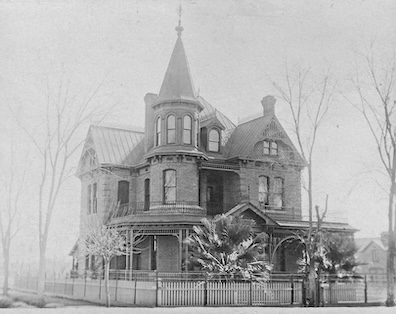
Photo of Rosson House, circa 1908 – a Queen Anne style Victorian Era home built in 1895, that is not an eyesore, nor is it ugly, disfigured, awkward, chaotic, excessive, or haunted. So there!
Not to be outdone, architects from the early 1900s disliked the excess of Victorian Era homes as well. Frank Lloyd Wright, whose designs followed uncluttered, clean lines, called the stately stretch of Victorian Era homes along Summit Avenue in St. Paul, MN, “the worst collection of architecture in the world”. Architect Talbot Hamlin, who was a professor of architecture at Columbia University and an American Institute of Architects fellow, said in his book The American Spirit in Architecture (1926), that Victorian Era architecture demonstrated, “rampant commercialism (and) chaotic ugliness”, and were “disfigured, strange, and awkward monstrosities”. The popular magazine House & Garden featured architects like H. Vandervoort Walsh, who, in his article, “Laying the Ghost of a Victorian House” (July 1928), actively advocated for stripping all the ornamentation from homes of that period to “modernize” them, saying that the “majority of late 19th century residences have a sad, gloomy quality” with details that “stir our imaginations to think of ghosts and evil spirits”. The same magazine included an ad in their October 1928 issue that cautioned readers against having rooms that resemble, “that dark, closed-up, musty…mid-Victorian chamber-of-horrors – the parlor”. (Note: Following opinions like these, it’s a wonder any late 19th century homes still exist!)
-
Poem: Antigonish - By Hughes Mearns (1899)
Yesterday, upon the stair,
I met a man who wasn’t there.
He wasn’t there again today
I wish, I wish he’d go away…When I came home last night at three
The man was waiting there for me
But when I looked around the hall
I couldn’t see him there at all!
Go away, go away, don’t you come back any more!
Go away, go away, and please don’t slam the door… (slam!)Last night I saw upon the stair
A little man who wasn’t there
He wasn’t there again today
Oh, how I wish he’d go away…
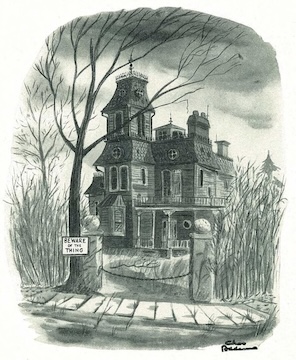
The Addams Family house, by Charles Addams, pictured in Addams and Evil, 1947.
HAPPENING HAUNTS
Hollywood would jump on the Victorian haunted house bandwagon as well, and two of the most prominent modern influences on how haunted houses are depicted are the Second Empire style homes made for the fictional Addams family, created by Charles Addams – first in comics for the New Yorker magazine in the late 1930s, and then in TV and film – and for the Bates Mansion in the Alfred Hitchcock classic, Psycho (1960). Reportedly Hitchcock was influenced by the Edward Hopper painting, House by the Railroad (1925), that still strikes many as unsettling. And though Addams claimed there was no specific house that influenced his design of the Addams family home, the neighborhood where he grew up in Westfield, New Jersey, is filled with beautiful examples of architecture from the late Victorian Era.
Haunted houses of another sort pop up every spooky season as a place where actors in costumes and make up “haunt” temporary exhibits set up in empty storefronts, carnivals, corn mazes, theme parks, and more, with the sole purpose of scaring the pants off their visitors. And though this may seem like a new addition to the Halloween holiday, these scary spots have their origins with experiences like Madame Tussaud’s Wax Museum “Chamber of Horrors” (first displayed in 1802), and what’s thought to be the original “haunted house” attraction in Liphook, England (circa 1915). By the early 1900s, US schools and communities were setting up “haunted houses” and “tunnels of terror” as a way to keep unruly kids from damaging property on Halloween night. Both the Winslow Daily Mail (November 5, 1910) and the Arizona Republic (November 11, 1920) mention Halloween parties that included haunted houses, with the latter reported as “harrowing and nerve racking”, but also popular enough to help raise $47 for the school library (equaling approximately $739 today). A Halloween party instruction book from 1937 even recommended hosting such festivities in a dilapidated old house, and to “hang old fur (and) strips of raw liver on walls” for people to touch as they feel their way through the darkened home. (YUCK)
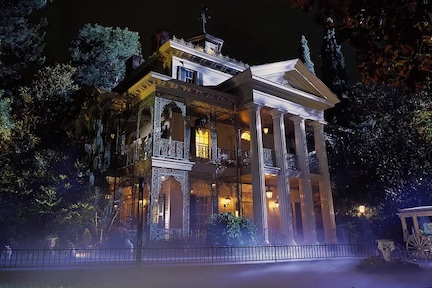
Haunted Mansion, Disneyland, photo by Paul Hiffmeyer.
Today, you can still find “haunted houses” of one kind or another just about anywhere – in books, TV shows, and movies; seasonally for Halloween; all the time as the “Haunted Mansion” in Disney theme parks; or by visiting homes that are actually supposed to be haunted, like the “Conjuring” House in Burrillville, RI (built in 1736), the Winchester House in San Jose, CA (built between 1884-1922), and the Amityville House in Amityville, NY (built in 1927). But please remember – just because a house is Victorian, it doesn’t mean it’s haunted!
STAFF PICKS
Spooky season is a favorite amongst our staff, and we have a few favorite “haunted” stories we’d like to share:
-
- Turn of the Screw, by Henry James
- House of Leaves, by Mark Z. Danielewski
- Death at the Manor, by Katharine Schellman
- The London Seance Society, by Sarah Penner
- A Dreadful Splendor, by B.R. Myers
- The Sittaford Mystery, by Agatha Christie
- And of course, The Haunting of Hill House, by Shirley Jackson, which was our September Book Club read!
Banner photo – Lyons Mussina House, Lock Haven, PA (built 1869 – demolished 1975); Library of Congress, Historic American Buildings survey photo (c1933)
Information for this article was found online through the Library of Congress Chronicling America and Newspapers.com digital newspaper archives; as well as from The Collector – Ancient Ghost Stories from Around the World; History – History of Ghost Stories; Smithsonian Magazine – 3,500-Year-Old Babylonian Tablet…; ThoughtCo – …Nekuia, in Which Odysseus Speaks to Ghosts; Discentes (University of Pennsylvania) – Roman Ghost Stories & Superstitions…; the New York Public Library Blog – A Brief History of Gothic Horror; JSTOR – Better for Haunts: Victorian Houses and the Modern Imagination, American Art Vol. 26, No. 3 (Fall 2012); Los Angeles Review of Books – Haunted by Houses: On the California Victorian in Fiction; JSTOR Daily – How Victorian Mansions Became the Default Haunted House; Smithsonian Magazine – A Brief History of the Haunted House; ArchiPanic – The Victorian Haunted House From Psycho to Stranger Things; Thesaurus – The Hair-Raising History of the Haunted House Story; Visit St Paul – Summit Avenue History: The Story of Saint Paul’s Famous Street; Smithsonian Magazine – A Brief History of the Haunted House; The Ghost in my Machine – The Fascinating & Gruesome History of Madame Tussauds…; NPR – How the cartoonist behind The Addams Family defused fear…; Pieces of History, National Archives – Private Charles Samuel Addams: Creator of the Addams Family; and Trick or Treat: A History of Halloween, by Lisa Morton (via Internet Archive).
Archive
-
2025
-
January (1)
-
-
2024
-
December (1)
-
November (1)
-
October (1)
-
September (1)
-
August (1)
-
July (1)
-
June (1)
-
May (1)
-
April (1)
-
March (1)
-
February (1)
-
January (1)
-
-
2023
-
December (1)
-
November (1)
-
October (1)
-
September (1)
-
August (1)
-
July (1)
-
June (1)
-
May (1)
-
April (1)
-
March (1)
-
February (1)
-
January (1)
-
-
2022
-
December (1)
-
November (1)
-
October (1)
-
September (1)
-
August (1)
-
July (1)
-
June (1)
-
May (1)
-
April (1)
-
-
2021
-
December (1)
-
November (1)
-
October (1)
-
September (1)
-
August (1)
-
July (1)
-
June (1)
-
May (1)
-
April (1)
-
March (1)
-
February (1)
-
January (1)
-
-
2020
-
December (1)
-
November (1)
-
October (1)
-
September (1)
-
August (1)
-
July (1)
-
June (1)
-
May (1)
-
April (1)
-
March (1)
-
February (1)
-
January (1)
-
-
2019
-
December (1)
-
November (1)
-
October (1)
-
September (1)
-
August (1)
-
July (1)
-
June (1)
-
May (1)
-
April (1)
-
March (1)
-
February (1)
-
January (1)
-
-
2018
-
December (1)
-
November (1)
-
October (1)
-
September (1)
-
August (1)
-
July (1)
-
May (1)
-
April (1)
-
March (1)
-
February (1)
-
January (1)
-
-
2017
-
December (1)
-
November (1)
-
October (1)
-
September (1)
-
August (1)
-
July (1)
-
June (1)
-
May (1)
-
April (1)
-
March (1)
-
February (1)
-
-
2016
-
December (1)
-
-
2015
-
2014
-
July (1)
-
